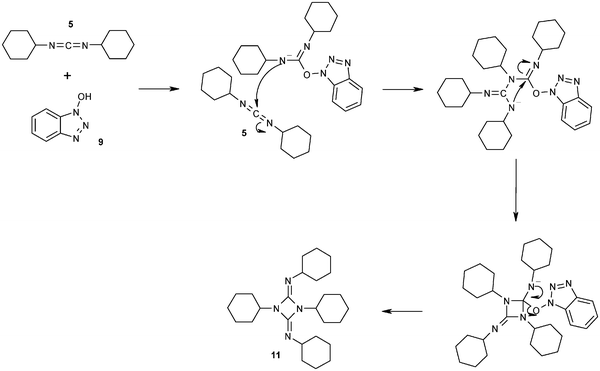Dicyclohexylcarbodiimide dcc 5 has been used for coupling since 195521 and the mechanism for coupling carboxylic acids to amines is shown in scheme 2. The reaction consists of two con secutive steps.
Steglich Esterification

Unveiling And Tackling Guanidinium Peptide Coupling Reagent Side

Scheme Of The O Alkylation Of 8 Hydroxyquinoline 3 Peptide Coupling
The additive is essential to reduce isomerization to acceptable levels.

Dcc peptide coupling. Dcc has achieved popularity mainly because of its high yielding amide coupling reactions and the fact that it is quite inexpensive. Although the racemization suppressing capacity of hodhbt 11 is greater than that of hobt 12 its utility was limited due to side reactions. Nn dicyclohexylcarbodimide dcc introduced in peptide synthesis by sheehan and hess in 1955.
It is widely used for amide and ester formation especially for solid phase peptide synthesis. It is a waxy white solid with a sweet odor. The rst step involves the reaction of the carboxylic acid with dcc to form the o acylurea 6.
This is probably the most common method of coupling segments with hobt as the most efficient additives. However because dcc is not aqueous soluble it is primarily used in manufacturing and organic synthesis applications rather than in the typical protein research biology lab. The chemistry behind and the.
During the first step the protected amino acid or pep tide reacts with a so called coupling reagent yielding a reactive intermediate. Activation of the carboxy moiety 2. Nn dicyclohexylcarbodiimide dcc is an organic compound with the chemical formula c6h11n2c.
Its primary use is to couple amino acids during artificial peptide synthesis. Acylation of the amino group. It is highly soluble in dichloromethane tetrahydrofuran acetonitrile and dimethylformamide but insoluble in water.
Depbt 99 derived from depc 87 and hodhbt 11 has been evaluated against other peptide coupling reagents and gave good results in segment coupling reactions. Dcc and edc are often used with an additive. Dcc dicyclohexyl carbodiimide crosslinks carboxylic acids to primary amines in the same manner as edc see reaction schemes above.
Dcc acronym for nn dicyclohexylcarbodiimide was one of the first carbodiimides developed as a reagent. The low melting point of this material allows it to be melted for easy handling.

Coupling Reagents Sigma Aldrich

Details About N N Dicyclohexylcarbodiimide Dcc Peptide Coupling Reagent 100g 98

Amide Bond Formation Beyond The Myth Of Coupling Reagents

EmoticonEmoticon